
Bioenergy
Principles and Applications
Yebo Li, Samir Kumar Khanal
- English
- ePUB (handyfreundlich)
- Über iOS und Android verfügbar
Bioenergy
Principles and Applications
Yebo Li, Samir Kumar Khanal
Über dieses Buch
BIOENERGY:
PRINCIPLES AND APPLICATIONS
BIOENERGY: PRINCIPLES AND APPLICATIONS
With growing concerns over climate change and energy insecurity coupled with dwindling reserves of fossil energy resources, there is a growing search for alternative, renewable energy resources. Energy derived from renewable bioresources such as biomass (energy crops, agri- and forest residues, algae, and biowastes) has received significant attention in recent years. With the growing interest in bioenergy, there has been increasing demand for a broad-ranging, introductory textbook that provides an essential overview of this very subject to students in the field. Bioenergy: Principles and Applications offers an invaluable introduction to both fundamental and applied aspects of bioenergy feedstocks and their processing, as well as lifecycle and techno-economic analyses, and policies as applied to bioenergy.
Bioenergy: Principles and Applications provides readers with foundational information on first-, second-, and third-generation bioenergy, ranging from plant structure, carbohydrate chemistry, mass and energy balance, thermodynamics, and reaction kinetics to feedstock production, logistics, conversion technologies, biorefinery, lifecycle and techno-economic analyses, and government policies. This textbook gives students and professionals an incomparable overview of the rapidly growing field of bioenergy.
Bioenergy: Principles and Applications will be an essential resource for students, engineers, researchers, and industry personnel interested in, and working in, the bioenergy field.
Häufig gestellte Fragen
Information
SECTION III
Biological Conversion Technologies
CHAPTER 12
Pretreatment of Lignocellulosic Feedstocks
What is included in this chapter?
12.1 Introduction


12.2 What Does Pretreatment Do?
Inhaltsverzeichnis
- Cover
- Title Page
- Table of Contents
- List of Contributors
- Preface
- Acknowledgments
- About the Companion Website
- SECTION I: Bioenergy Fundamentals
- SECTION II: Bioenergy Feedstocks
- SECTION III: Biological Conversion Technologies
- SECTION IV: Thermal Conversion Technologies
- SECTION V: Biobased Refinery
- SECTION VI: Bioenergy System Analysis
- Index
- End User License Agreement